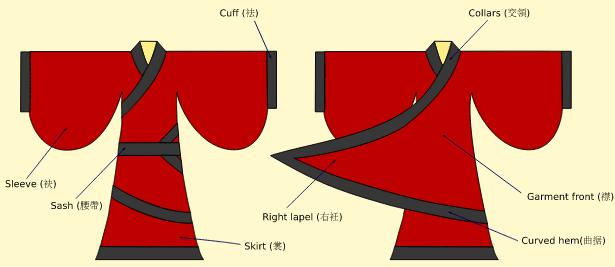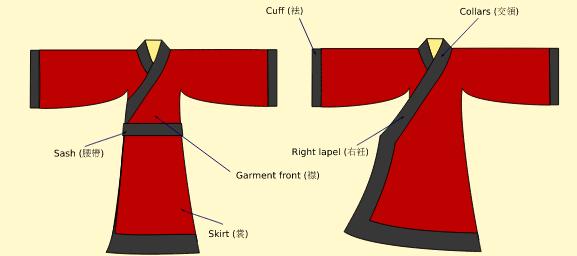Garments
The style of Han Chinese clothing can be summarized as containing garment elements that are arranged in distinctive and sometimes specific ways. This may be different from the traditional garment of other ethnic groups in China, most notably the Manchu-influenced Chinese clothes, the qipao, which is popularly assumed to be the solely recognizable style of "traditional" Chinese garb.

A complete Hanfu garment is assembled from several pieces of clothing into an attire:
Yi : Any open cross-collar garment, and worn by both sexes
Pao : Any closed full-body garment, worn only by men in Hanfu
Ru : Open cross-collar shirt
Shan : Open cross-collar shirt or jacket that is worn over the yi
Qun or chang : Skirt for women and men
Ku : Trousers or pants
People are also able to accessorize with tassels and jade pendants or various ornaments hung from the belt or sash, known as pei .
Hats and headwear
On top of the garments, hats (for men) or hairpieces (for women) may be worn. One can often tell the profession or social rank of someone by what they wear on their heads. The typical types of male headwear are called jin for soft caps, mao for a stiff hats and guan for formal headdress. Officials and academics have a separate set of hats for them, typically the putou, the wushamao, the si-fang pingding jin; or simply, fangjin: and the Zhuangzi jin. A typical hairpiece for women is a ji but there are more elaborate hairpieces.
Style
Han-Chinese clothing had changed and evolved with the fashion of the days since its commonly assumed beginnings in the Shang dynasty. Many of the earlier designs are more gender-neutral and simple in cuttings. Later garments incorporate multiple pieces with men commonly wearing pants and women commonly wearing skirts. Clothing for women usually accentuates the body's natural curves through wrapping of upper garment lapels or binding with sashes at the waist.
Each dynasty has their own styles of Hanfu as they evolved and only few styles are 'fossilized'.
Informal wear
Types include tops (yi) and bottoms (divided further into pants and skirts for both genders, with terminologies chang or qun), and one-piece robes that wrap around the body once or several times (shenyi).

Zhongyi or zhongdan : inner garments, mostly white cotton or silk
Shanqun : a short coat with a long skirt
Ruqun : a top garment with a separate lower garment or skirt
Kuzhe : a short coat with trousers
Zhiduo/zhishen : a Ming Dynasty style robe, similar to a zhiju shenyi but with vents at the side and 'stitched sleeves' (i.e. the sleeve cuff is closed save a small opening for the hand to go through)
Daopao/Fusha : Taoist/Buddhist priests' full dress ceremonial robes
Semi-formal wear
A piece of Hanfu can be "made semi-formal" by the addition of the following appropriate items:
Chang: a pleated skirt
Bixi : long front cloth panel attached from the waist belt
Zhaoshan : long open fronted coat
Guan or any formal hats
Generally, this form of wear is suitable for meeting guests or going to meetings and other special cultural days. This form of dress is often worn by the nobility or the upper-class as they are often expensive pieces of clothing, usually made of silks and damasks. The coat sleeves are often deeper than the shenyi to create a more voluminous appearance.
Yuanlingshan

Formal garments may include:
Xuanduan a very formal dark robe; equivalent to the Western white tie
Shenyi: a long full body garment
Quju: diagonal body wrapping
Zhiju: straight lapels
Yuanlingshan , lanshan or panlingpao: closed, round-collared robe; mostly used for official or academical dress
Court dress
Court dress is the dress worn at very formal occasions and ceremonies that are in the presence of a monarch (such as an enthronement ceremony). The entire ensemble of clothing can consist of many complex layers and look very elaborate. Court dress is similar to the xuanduan in components but have additional adornments and elaborate headwear. They are often brightly colored with vermillion and blue. There are various versions of court dress that are worn for certain occasions.
Court dress refers to:






